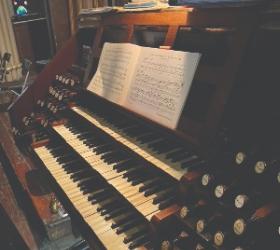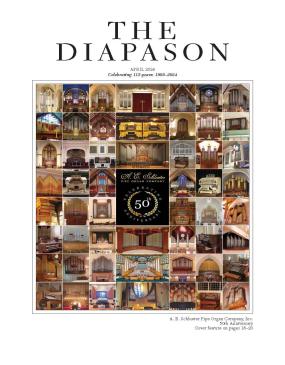
Facsimiles from Fuzeau: Sources for Lifelong Learning
Alternately fascinating and frustrating, facsimiles of original manuscripts and printed editions have become increasingly available. For the harpsichordist there is little that is more rewarding than playing from an actual musical “picture” as presented by the composer. Reading from the “original” certainly does not answer all questions, but it does give an unadulterated source as basis for making one’s own musical decisions. For this reason, I heartily recommend playing from facsimiles as a challenging, and often a cleansing, exercise in musical growth.
To utilize these recent scores from publisher Jean-Marc Fuzeau of France, it will help to have an adventurous spirit, as well as a willingness to learn the occasional unfamiliar clef, frequently used in earlier music manuscripts to avoid excessive employment of ledger lines.
Alessandro Poglietti: Rossignolo [Collection Dominantes Number 5905].
Works for harpsichord or organ by the Italian composer who died in 1683 during his flight from Vienna following the Turkish siege of that city. Three main sources for these pieces are introduced by Peter Waldner, whose notes in French, English, and German include both biographical and bibliographical information and a listing of available modern editions. Fuzeau’s publication comprises three slim paperbound volumes in a folder: an autograph manuscript from the Austrian National Library, Vienna (Cod. 19248), an early edition from the Music Library of the Benedictine Monastery of Marienberg, Burgeis (60/q 366), and another copy of an old source, now housed in the Deutsche Staatsbibliothek, Berlin (Mus.ms. 17670). All utilize the soprano clef (notes written a third higher than the customary G clef) and the familiar bass clef on F. Individual pieces include a Toccata, Canzone, Allemande Amour, Courante, Sarban, Gigue, Ayre, as well as Il Rossignolo Capricio [sic] and a Petitte Ayre gay “in imitation of the Nightingale.”
Johann Kuhnau: Neue Clavier-übung, Partie I (1689) [Collection Dominantes Number 5716], consists of seven short keyboard suites in C, D, E, F, G, A, and B-flat, prefaced by eleven pages of introductory material by Philippe Lescat. Each group of pieces begins with a Prelude (the fourth suite, a Sonatina). The volume is engraved in a large, clear format employing the first line soprano clef and the familiar bass clef on F.
For a modern performing edition of these works (and others, including the popular and appealing Biblical Sonatas) by Bach’s immediate predecessor as Cantor of Leipzig’s Thomaskirche, consult the beautifully-presented two-volume set of Kuhnau’s Collected Works for Keyboard edited by C. David Harris, available from The Broude Trust, New York (ISBN 0-8540-7660-4).
Christoph Graupner: Monatliche Clavir Früchte (1722) [Collection Dominantes Number 5855].
Not surprisingly, this collection of “Monthly Keyboard Fruits” comprises twelve groups of keyboard pieces illustrating the months of the year. (I suppose one could create a larger work--Seasons--by playing these suites in groups of three!) Graupner, student of and assistant to Kuhnau in Leipzig, spent most of his distinguished career in Darmstadt. Soprano and bass F clefs, notes by Oswald Bill.
Louis Marchand: Pièces de clavecin (Book I, 1699; Book II, 1702), Air (La Venitienne) [La Musique Française Classique Number 5761].
Book One contains a Suite in D minor, consisting of a (measured) prelude and eight dance movements (including an elegant Chaconne with four couplets) engraved primarily in soprano and third line F clefs (with occasional deviations to G and third line C clefs). Book Two contains a Suite in G minor, the prelude of which has some unmeasured passages. Seven short dance movements follow.
Edited by Thurston Dart, Marchand’s two suites were published by Editions L’Oiseau Lyre in 1960. Dart’s edition does not contain the short Air (printed by Ballard as the character piece “La Venitienne” [in Pièces Choisies pour le clavecin]), included in the facsimile (with easy-to-read G and F clefs). Introductory notes to Fuzeau’s publication include an essay on “French Harpsichord Makers of Marchand’s Time” by Philippe Lescat. An amusing attribution in his Bibliography replaces American harpsichord maker and instrument historian FRANK Hubbard’s first name with the more Gallic spelling FRANCK.
Christian Gottlob Neefe: Zwölf Klavier-Sonaten (1773) [Collection Dominantes Number 5880].
Twelve early classic works for clavichord by Beethoven’s teacher; published in Leipzig with a dedication to “Herr Kapellmeister [C P E] Bach in Hamburg.” The original print featured a clear, clean text (soprano, bass F clefs). The inevitable printer’s errors are noted and corrected in introductory material by Pascal Duc.
Number Twelve in the Fuzeau series Méthodes & Traités fills two volumes, each containing more than 200 pages. Clavecin presents in chronological order selections from the most important French sources concerning the harpsichord. A reading knowledge of French would be helpful, but for those who are challenged by the language, a great amount of enjoyment may be gleaned from the generous offering of harpsichord-related images, easily-deciferable information, and the many musical examples.
Beginning with tuning and building information from Mersenne’s Harmonie universelle (1636) and Denis’ Traité de l’accord de l’espinette (1650), volume one continues with ornament tables found in the keyboard volumes by Chambonnières (1670), d’Anglebert (1689), Dieupart (1701: a volume dedicated to the Countess of Sandwich), Le Roux (1705), François Couperin (Book I, 1713), Dandrieu (1724), Dagincourt (1733), Michel Corrette (1734), Louis-Claude Daquin (1735), Rameau (1736), Van Helmont (1737), Jollage (1738), and Royer (1746), plus complete facsimiles of Saint-Lambert’s Les Principes du Clavecin, (1702) and Couperin’s L’art de toucher le clavecin (1717). [Consult the original layout of Couperin’s Troisième Prélude (page 175) to substantiate a correct reading of the never-corrected faulty first bass note at the beginning of the last score: the guide (guidon) from the preceding line shows it to be a “C,” but the engraver actually notated a “B-flat,” creating a chord unidiomatic to an 18th-century piece.]
Also included are two documents including important information for stylistic performance of French keyboard music: a letter by Le Gallois concerning the playing of the prélude non mésurée (1680) and Rameau’s two-page commentary on proper touch at the harpsichord (1724), ending with his intriguing comment that the same techniques are applicable as well to the organ.
Volume Two continues this rich treasure trove with Michel Corrette’s Les Amusemens du Parnasse, a short and easy method for the harpsichord (1749). This includes a simple Suite in C for beginners, with fingerings provided AND utilizing the familiar G and F clefs, followed by an additional twelve pages of easy pieces. At the end of the volume Marpurg’s Art de toucher le clavecin (1797) gives a fin de siècle example of keyboard instruction, concluding with another lengthy set of easier pieces by Mr. Sorge, organist and mathematician of Lobenstein (once again using “modern” clefs).
Other gems reprinted in this second volume include composer Duphly’s handwritten remarks on fingering (1769) as preserved in the copy of his Pièces de clavecin, Book I, belonging to his student, English Lord Fitzwilliam; illustrations of harpsichord construction from Diderot’s Encyclopédie (1751- 1772); Lessons and Principles of Harmony by Bemetzrieder (1771) reproduced from a copy once owned by the important 19th-century musical reformer Choron; and several more enchanting engravings of variously styled harpsichords with other instruments from the Essai sur la musique ancienne et moderne by Laborde (1780).
For more complete details, including current prices, consult the publisher’s website: <classical-music.fuzeau.com>. A recent promotional offering, a miniature volume of selected pages from facsimile publications, is offered at this address. Let your discoveries begin!
Send news items or comments about Harpsichord News to Dr. Larry Palmer, Division of Music, Southern Methodist University, Dallas, TX 75275;




